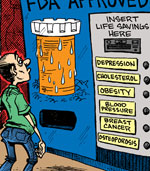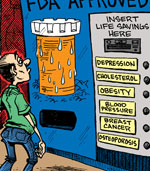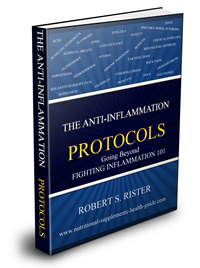The Power of Vitamin A Creams and Skin Creams
| Share on Facebook | Share on Twitter | Share on Google+ |
Vitamin A is the world's best known treatment for the world's most common skin condition, acne, although the anti-acne products are not usually identified as vitamin A. The most potent pharmaceutical treatments for acne are actually very potent vitamin A creams.
The drugs isotretinoin (also known as Accutane, Roaccutane, Amensteem, Claravis, Clarus, Decutan, Izotek, Sotret, and others) and tretinoin (also known as Retin-A, Aberela, Airol, Renova, Atralin,Avita, or Stieva-A) are super-charged formulations of vitamin A that cause the skin to grow so rapidly it literally opens up over deep-seated cysts and boils. Vitamin A in a super-potent formulation can save acne sufferers the need of having surgery to get rid of painful cystic acne.
The problem with these well-known medications, however, is that they work a little too well. They contain so much vitamin A that they can cause liver damage, depression, and birth defects. Users have to report to their doctors at least once a month for blood tests (usually not covered by insurance) to make sure the massive dose of vitamin A is not toxic.
You'd think there would be a better way. And there is. A form of vitamin A known as retinyl palmitate is not as dramatically effective as isotretinoin and tretinoin, but it's far less expensive and it also can generate steady and reliable improvement in skin affected by acne or cellulite.
Vitamin A Face Cream for Acne
The kinder, gentler approach to treating acne is to use a vitamin A face cream made with retinyl palmitate. When the skin absorbs retinyl palmitate, it turns it into the active form of vitamin A, retinol, but it only releases enough retinol to support slower growth of the skin. This encourages the skin to grow around blackheads and simply let the blackhead fall out on its own.
Generally, users apply vitamin A face cream every other night to make sure the skin is not overstimulated and irritated—two common problems with Accutane and Retin-A. A lower-strength, non-prescription vitamin A cream, however, will not cause blackheads, whiteheads, and pimples, which are common problems with Accutane and Retin-A.
Vitamin A Creams for Cellulite
Cellulite, sometimes colloquially called "thunder thighs," is a condition of bumpy skin on women's thighs. The reason women get this condition is that the fat cells underneath the skin of their thighs are elongated, standing up in rows oriented perpendicular to the skin and to the flesh below them. When they get filled with either fluid or fat, they are visible as tiny bumps on the skin, often likened to an orange peel.
Cellulite is hard to get rid of. Some of the most drastic procedures to remove cellulite, such as surgery, have an extremely undesirable side effect: Creating additional cellulite! But researchers have found that a combination of intense pulse light and a vitamin A cream can, after about 10 treatments, make cellulite largely disappear.
You don't have to use a vitamin A cream to fight cellulite. The pulse light therapy will work on its own. Applying retinyl palmitate creams to the thighs before and after treatment, however, helps the skin recover from dimpling even faster.
Other Applications for Vitamin A Creams
Vitamin A Creams aren't just for acne and cellulite. They are also used on warts, wrinkles, psoriasis, and for thinning thick skin. And remember, gels dry out and wrinkle your skin, while creams hydrate and smooth your skin. Always make sure you use vitamin A as a cream, not a gel, and never in an alcohol-based product. Watch out for:
- Burning/Stinging
- Peeling/Exfoliation
- Redness
- Sunburn
If these occur, use less of the cream. And the first time you use any new vitamin A cream, try a tiny test spot on skin that won't be noticeable just be make sure that you are not sensitive to the strength of vitamin A used in the product. Keep vitamin A creams out of your eyes, and don't apply them to broken skin.
Selected References:
Fink JS, Mermelstein H, Thomas A, Trow R. Use of intense pulsed light and a retinyl-based cream as a potential treatment for cellulite: a pilot study. J Cosmet Dermatol. 2006 Sep;5(3):254-62.
-
E-BOOK FOR EVERYONE
FIGHTING INFLAMMATION 101
Evidence-Driven Natural HealingGet Your Free-Ebook below

Don't worry -- your e-mail address is totally secure. I promise to use it only to send you "The Nutritional Path to Health" Ezine. -
Skin CareMen Skin Care
-
Free ResourcesFree eBooks
-
Every person is a God in embryo. Its only desire is to be born.Deepak Chopra
-
Featured Health SupplementTotal Balance is like no other
 … in that it utilizes state of the art delivery systems not generally used in a supplement...
… in that it utilizes state of the art delivery systems not generally used in a supplement...
-




















